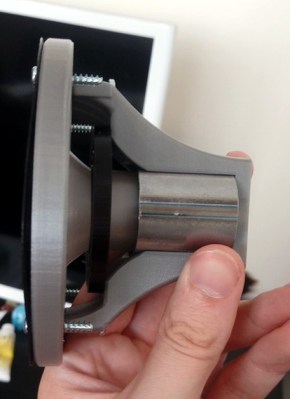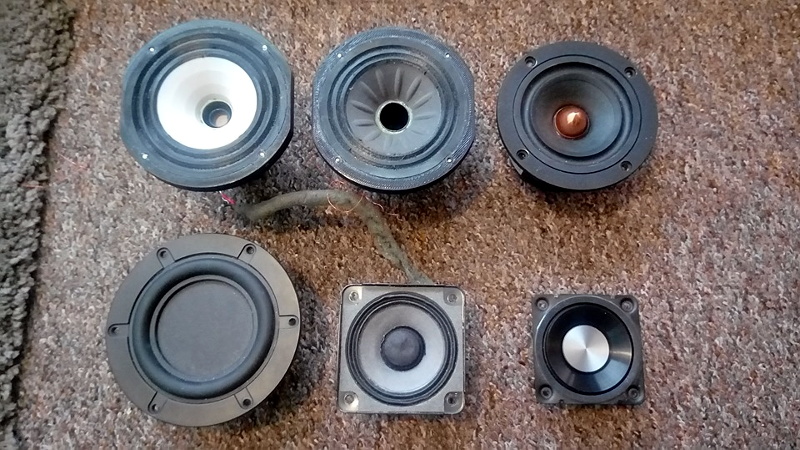Over the years, we’ve seen numerous projects that attempted to 3D print speaker enclosures that deliver not only a bit of custom flair, but hopefully halfway decent sound. Though as you’d probably expect, the drivers themselves are always standard run-of-the mill hardware mounted into the plastic enclosure. But given the research being conducted by [Paul Ellis], that might not be a safe assumption for much longer.
 His quest to develop a full-range 3D speaker has taken him through several design revisions over the last two years, with each one being put through testing procedure that compared its frequency response to “real” speakers from manufacturers like Dayton and Bose. The project is very much ongoing, but a recently completed iteration of the driver design managed to exceed 80 dB at 1 W. In terms of audio quality, [Paul] reports they can hold their own against commercially available drivers. You can hear for yourself in the video after the break.
His quest to develop a full-range 3D speaker has taken him through several design revisions over the last two years, with each one being put through testing procedure that compared its frequency response to “real” speakers from manufacturers like Dayton and Bose. The project is very much ongoing, but a recently completed iteration of the driver design managed to exceed 80 dB at 1 W. In terms of audio quality, [Paul] reports they can hold their own against commercially available drivers. You can hear for yourself in the video after the break.
Ultimately, he hopes to be able to sell his 3D printed speakers in kit form to anyone who’s looking for the last word in bespoke audio hardware. The idea being that the drivers and enclosure will be completely modular, allowing the user to swap out individual components for ones printed (or not) in different materials so they can tune the in-person sound to their exact specifications. To facilitate this rapid reconfiguring of the drivers, the designs use some neat tricks like having the magnets be removable rather than glued in so they could be swapped out non-destructively.
This isn’t the first fully 3D printed speaker driver we’ve ever seen, Formlabs showed one off that was made on their SLA printer back in 2015, and we actually saw a rudimentary take on the same idea earlier this year. But the work that [Paul] has done here is certainly the most thorough, and dare we say practical, take we’ve ever seen on the concept.
















3D printing the diaphragm too?
curious to see the life expectancy of a printed diaphragm ??
i don’t think it would break easily, even if it is made out of TPU or some flex material. I was legitimately surprised about layer adhesion on TPU, plus it wouldn’t dry out like some materials they use for the diaphragms. it’s not as soft though.
Hello everyone. Paul here. Yes the surround and the spider are 3D printed. They over time have changed material but the one in use in the videos and still is used is Fillamentum 92A. The pair of speakers in the black cabinets are the most tested so far with over 200 hours of use and a 4 hours test of 10W @ 15Hz to observe tearing and issues when pushing excursion. I have also had it used by other people so that they will push it more than maybe I would. Typical power handling will be around 5W per channel, but you got to push it in testing. I had to make the surround and spider printed so I can make sure the linear motion of both components are close.
There is a thread of the diyaudio forum where I am open to any questions people have. The pair running for the longest so far will continue to be run daily to see how this suspension fairs but I don’t have any concerns right now.
https://www.diyaudio.com/forums/full-range/337129-polymate3d-fd61-3d-printed-range-speaker-driver-development-5.html
Paul
>driver design managed to exceed 80 dB at 1 W.
You realize that 80db = 10^4 have no physical units, right? i.e. 10,000 of WHAT?
In audio, usually dBA. For signal levels, dBm and dBW are often used since translating them to dBA at the output is simply a matter of adding/subtracting numbers at each point of the chain.
Yeah this is definitely dBA. dB-SPL is referenced to 20 uPa, which is considered the threshold of human hearing. A-weighting is a frequency weighting of an SPL measurement meant to match the frequency sensitivity of the human ear at 40 dB-SPL. There are clearly many issues with using dBA, but it’s the standard for lack of a better way.
But it still needs a distance to be meaningful. Unless it is a sound power rating, which it isn’t. But I guess we can get the idea from the video.
Hello. The results are gained from a WT3 Analyser to gain Thiele & Small parameters. I have put a link down to the exact post the 80dB driver was detailed on the diyaudio forum. The measurement is 80dB @ 1W @ 1m. Hope this helps.
https://www.diyaudio.com/forums/full-range/337129-polymate3d-fd61-3d-printed-range-speaker-driver-development-2.html#post5866171
Paul
“You can hear for yourself in the video after the break.”
sounds like the cheap speakers in my dell laptop … cause that’s what I am listening to not the speaker in the video ;P
Hello. Yeah I complete get this and it is a big hurdle to overcome. I am starting by having it be on show at the advanced engineering show at the NEC in Birmingham and hoping to get feedback through this that are not people I know. Then it is trying to get it out to people who are more well known and people respect there opinion. Step by step :)
Though, you could show the frequency response graph in the video, with something to compare it with.
I guess some reading this may not be aware of the fallacy. But can I be the first to say a resounding “we know!!!”
On the flip side, being an enthusiast, I can say that I know my PCs speakers well and can certainly tell when something sounds good by naturally comparing it to the multitude of other examples I’ve heard through the same speakers over time.
I’m fine with the video, it shows the physical action of the speaker, and the audio demonstrates that the sound is clear. You can’t do much else remotely. Now you need to add some mirrors to the driver and LEDs on the perimeter to make a light show. Nice job!
Hi guys. I think Paul did a bloody good job with this. I am amazed at the fact that 3d printing can produce speaker drivers. Being an audiofile myself, i appreciate things like this. Paul, big high five to you bro. This is brilliant. And could hold a huge future in audio development. Keep at it. Developments like this helps build a better future.
I agree. While it’s difficult to truly hear the frequency response by listening to headphones or speakers on a computer, you can tell that this speaker is playing multiple different frequencies (across the entire spectrum) at the same time and it plays them clearly/cleanly. To that, I say, “Well Done!”. Audio is no easy thing to master, but I think Paul has done a great job designing these speakers. There is no telling how much time he has actually spent in studying, understanding, testing, prototyping, etc. Again, Nice Job!